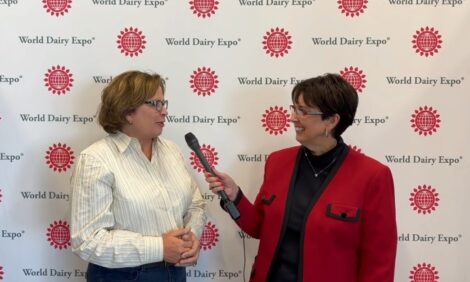



South African Drought: No Relief in Sight
SOUTH AFRICA - In spite of wide spread rain over many parts of the drought-stricken summer rainfall area of South Africa, chances remain low that the impact of drought will soon be broken. Glenneis Kriel reports.Over the past week social media has been swamped with photos of South African farmers dancing and praying in the rain. There has even been reports of flooding in a handful of towns. Prospects nevertheless remain bleak that the region will break out of the grip of the drought this season.
Gerhard Schutte, CEO of the Red Meat Producers Organisation (RPO) confirmed that there has been relief in many of provinces, but the situation is still critical in the central parts of the country.
“The rain should be seen in perspective. The country has already lost more than three months worth of pastures, so the situation won’t be salvaged even if we had widespread precipitation now.
"Grazing and crop residues will remain limited in the summer rainfall areas, with the situation worsening over winter. We therefore expect emergency culling to continue until June July,” he said.
Simon Streicher, CEO of the South African Pork Producer Organisation (SAPPO) agreed with Mr Schutte.
He said that even if it rained well now, it would be too late for many farmers to recover the knock they are taking: “Up to 60 per cent of pig feed is comprised of maize and because maize farmers have been unable to plant decent crops this season, the price for available maize increased by 70 per cent since last year February. Many pork producers are in difficulty and are facing financial hardships.”
Mr Streicher said the picture was especially bleak for emerging farmers: “They either feed their families or look after their farms. The choice they make is obvious.”
Prospects for good rain in the summer rainfall area the rest of the season also remain bleak. The country has recorded the lowest annual rainfall in more than a hundred years in 2015, according to the South African Weather Services. Where annual rainfall averaged around 608 mm since 1904, the country only recorded an average of 408 mm in 2015.
Cobus Olivier, a scientist from the South African Weather Services, forecast that precipitation will remain below normal in the summer rainfall areas this year and there was a chance that the region might receive even less rain than last year.
“Where we have moved in and out of El Nino conditions last year, it seems we are heading for a full-blown El Nino this year that might only end in June. By that time it will be too late, as the rainy season will then be over for the summer rainfall area,” Mr Olivier said.
Maize supply
Maize supply levels are critically low and the country, which under normal conditions is a net exporter of maize will have to import maize this year.
Dr Ferdi Meyer, director for the Bureau of Food and Agricultural Policy (BFAP), expects maize production to be no more than 1.3 million hectares, of which 230,000 hectares will be under irrigation. This will be the lowest number of maize hectares planted in the country, since 1932, and is half of what farmers intended to plant. Dams used for irrigation are also starting to run dry putting additional pressure on production.
Based on various factors, such as high temperatures and late planting, Dr Meyer predicted production to average around 3.62 tons per hectare in comparison with the industry’s 4.4 ton average under normal conditions. Total production will amount to about 4.7 million tons of which 1.9 million tons will be white maize for human consumption and 2.9 million tons will be yellow maize mostly for animal production. He said that this was less than half of the country’s total average annual consumption of 9.6 million tons.
Dr Meyer estimated that the country only had about eight months of white maize left at an average consumption rate of 360,000 tons per month. Consumption for yellow maize averaged around 500,000 tons per month, so it is expected that the country will run out of this resource sooner.
Jannie De Villiers, CEO of Grain SA, said that it shouldn’t be too difficult to source enough yellow, as yellow maize supply levels were high on the international market. Finding white maize however would be difficult, as there are only a few countries in the world besides Africa where large volumes of white maize is produced.
“We might have to contract farmers in other countries, such as America, to produce white maize for us, but by the time this maize will be ready to be shipped to us in November, we would have already run out of maize,” Mr De Villiers explained.
Logistics was another challenge. Mr De Villiers said the country wasn’t geared to import such high volumes of maize.
“South Africa annually import other grains, such as wheat, oilseeds, vegetable oil and feed cake, but the dry climatic conditions has increased the demand for these produce. Also, where trucks in the past used to fetch the produce and return with maize that had to be exported, they will now return empty.”
Durban harbour in KwaZulu-Natal only has the capacity to import about 2 million tons of maize, which means that supplies would have to also come from Cape Town, adding additional transportation costs.
He added that Cape Town harbour is subjected to windy conditions this time of year, which could result in boats being unable to unload supplies and further increasing costs. On top of this, some of South Africa’s neighbouring countries that are also struggling because of the drought, have indicated that they would also like to import maize via South Africa.
The financial impact
The South African currency, the Rand, has deteriorated significantly against major world currencies over the past year driving the cost of imports ups. Dr Meyer expects weakness of the currency to have an even more severe impact on food prices than the drought itself. According to Statistics by the South African Reserve Bank, the South African Rand (zar) has depreciated by more than 40 per cent against major currencies over the past year.
Dr Meyer said that maize meal prices have already increased by 20 per cent towards the end of last year. He expected it to increase by another 10 per cent in the first quarter of 2016. “The food basket for a family of four increases by 1,5 per cent for every 10 per cent with which the maize meal prices increases,” he said.
Mr De Villiers predicted that food inflation would increase by double digits, between 10 per cent and 15 per cent and cause overall inflation to increase from 4,55 per cent, as estimated in November 2015, to above 6 per cent this year.
Mr Streicher said that producing the same quality and quantity of pork products in these conditions is a challenge and output will decrease, which will obviously have a domino effect on supply and demand and increases in pork prices are unavoidable. “There is no alternative, they have to increase,” he said.
Mr Schutte predicted that prices for red meat will move sideways until the winter is over and that the price of beef will then increase by 10 per cent and for mutton by 12 per cent towards the end of the year. He predicted that prices will increase above inflation also in 2017.
Economic growth slowed down to 0.7 per cent during the third quarter of last year and Bloomberg recently predicted economic growth for 2016 around 1.4 per cent and a 25 per cent chance that the country might fall into a recession. South Africa already has one of the highest unemployment rates in the world and the situation is expected to result in even more job losses, as agriculture is the backbone of many small towns in the country, according to Mr De Villiers.
Mr De Villiers said that maize farmers in general lend about R8 million (335,279 GBP) each to cover their annual production costs: “While maize prices are very favourable, many of these farmers are heading for such low yields that the higher prices won’t make up for the lower yields. Many farms will go bankrupt, which will not only drive farm prices down, but also threaten our food security for next season, as it might take so long for farms to be transferred to new owners that the new owners won’t have time to plant during the next season.”
He said there has been many initiatives to help farmers, through for example feed donations for livestock. “There is however only that much feed in the country and once the country has run out of feed, we will be struggling to import more because of the logistics problem.”
TheCattleSite News Desk


